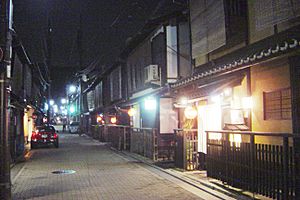Hanamachi facts for kids
A hanamachi is a special neighborhood in Japan. The word "hanamachi" means "flower town." These areas were once home to many traditional Japanese entertainers called geisha. Geisha are skilled artists who perform music, dance, and conversation for guests.
In a hanamachi, you would find okiya, which are houses where geisha live and train. There were also ochaya, or "tea houses," where geisha would entertain their guests. Today, hanamachi are quite rare. The most famous ones are still found in the city of Kyoto.
Contents
What is a Hanamachi?
A hanamachi is a historic district in Japan. It is known for its connection to geisha culture. These "flower towns" were the centers of traditional entertainment. They were places where geisha lived, trained, and performed. The name "flower town" comes from the beauty and artistry associated with geisha.
History of Hanamachi
Hanamachi have a long history in Japan. They developed over many centuries. In the past, these districts were lively places. They were filled with tea houses and geisha houses. People would visit hanamachi to enjoy the performances of geisha. Geisha were highly respected for their artistic talents. They kept many traditional Japanese arts alive.
Life in a Hanamachi
Life in a hanamachi revolved around the geisha. Young women would begin their training at a young age. They learned to play musical instruments, dance, and sing. They also learned about poetry, tea ceremonies, and polite conversation. The okiya (geisha house) was like a family home for them. The ochaya (tea house) was where they showed their skills. Geisha would entertain guests with their art. They created a unique and elegant atmosphere.
Hanamachi Today
Today, only a few hanamachi still exist. The most well-known ones are in Kyoto. These areas continue to preserve geisha traditions. They are important cultural landmarks. Visitors can sometimes see geisha walking through the streets. These modern hanamachi keep the spirit of the "flower towns" alive. They remind us of Japan's rich artistic past.
Images for kids
See also
 In Spanish: Hanamachi para niños
In Spanish: Hanamachi para niños



